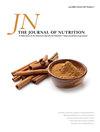膳食中糖和饱和脂肪的摄入量与孕期胃肠道微生物组的变化有关。
IF 3.7
3区 医学
Q2 NUTRITION & DIETETICS
引用次数: 0
摘要
背景:越来越多的证据表明,孕期胃肠道微生物组的变化可能会对母婴的短期和长期健康产生影响:我们的目的是探讨健康饮食指数(Healthy Eating Index,HEI)衡量的饮食质量与孕期母体胃肠道微生物组中微生物功能的组成和基因本体(Gene Ontology,GO)表征之间的关联:我们对参加孕期饮食特征研究(PEAS)的 185 名孕妇进行了回顾性观察分析。在妊娠头三个月,使用自动自控 24 小时回顾法(ASA24)对孕妇的饮食摄入量进行评估,并据此计算出 2015 年健康饮食指数。我们在妊娠后三个月采集了直肠拭子,并使用 NovaSeq 6000 系统霰弹枪平台进行了测序。我们使用无监督聚类来识别代表母体类群和 GO 功能项组成的微生物肠型。在控制相关协变量的同时,我们使用多变量线性模型来确定类群、功能项和食物成分之间的关联。然后使用多项式回归法根据参与者的 HEI 食物成分得分预测肠型成员:结果:与中等(M=27.35,SD=6.01)和低(M=27.49,SD=6.99)饮食质量三等分组相比,高饮食质量三等分组的孕早期体重指数较低(平均[M]=23.48 kg/m2,SD=3.38)(p结论:特定饮食成分与孕早期乳腺癌的发生有关:特定的膳食成分与妊娠后三个月的微生物组成和功能有关。这些发现为今后提出可检验的假设奠定了基础。本文章由计算机程序翻译,如有差异,请以英文原文为准。
Dietary Sugar and Saturated Fat Consumption Associated with the Gastrointestinal Microbiome during Pregnancy
Background
Growing evidence supports changes in the gastrointestinal microbiome over the course of pregnancy may have an impact on the short- and long-term health of both the mother and the child.
Objective
Our objective was to explore the association of diet quality, as measured by the Healthy Eating Index (HEI), with the composition and gene ontology (GO) representation of microbial function in the maternal gastrointestinal microbiome during pregnancy.
Methods
We conducted a retrospective, observational analysis of n = 185 pregnant participants in the Pregnancy Eating Attributes Study. Maternal dietary intake was assessed in the first trimester using the automated self-administered 24-h recall method, from which the HEI 2015 was calculated. Rectal swabs were obtained in the second trimester and sequenced using the NovaSeq 6000 system shotgun platform. We used unsupervised clustering to identify microbial enterotypes representative of maternal taxa and GO functional term composition. Multivariable linear models were used to identify associations between taxa, functional terms, and food components while controlling for relevant covariates. Multinomial regression was then used to predict enterotype membership based on a participant’s HEI food component score.
Results
Those in the high diet quality tertile had a lower early pregnancy BMI [mean (M) = 23.48 kg/m2, SD = 3.38] compared with the middle (M = 27.35, SD = 6.01) and low (M = 27.49, SD = 6.99) diet quality tertiles (P < 0.01). There were no statistically significant associations between the HEI components or the total HEI score and the 4 alpha diversity measures. Differences in taxa and GO term enterotypes were found in participants with, but not limited to, a higher saturated fat component score (β = 1.35, P = 0.01), added sugar HEI component (β = 0.07, P < 0.001), and higher total dairy score (β = 1.58, P = 0.01).
Conclusions
Specific dietary components are associated with microbial composition and function in the second trimester of pregnancy. These findings provide a foundation for future testable hypotheses.
求助全文
通过发布文献求助,成功后即可免费获取论文全文。
去求助
来源期刊

Journal of Nutrition
医学-营养学
CiteScore
7.60
自引率
4.80%
发文量
260
审稿时长
39 days
期刊介绍:
The Journal of Nutrition (JN/J Nutr) publishes peer-reviewed original research papers covering all aspects of experimental nutrition in humans and other animal species; special articles such as reviews and biographies of prominent nutrition scientists; and issues, opinions, and commentaries on controversial issues in nutrition. Supplements are frequently published to provide extended discussion of topics of special interest.
 求助内容:
求助内容: 应助结果提醒方式:
应助结果提醒方式:


